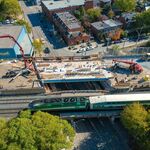BurlOak
Senior Member
It seems that a few month ago this thread seemed to think that about$1B per year was a good amount to fund transit. Now it seems that $2B per year is what is needed. It does show a couple of things. 1) Metrolinx has not properly publicised what it is doing and what the costs are for their plans. 2) It appears that the intent may be to eliminate current funding for transit and use that money for General Revenue. Then it will be the job of these revenue sources to make up the differnce, plus any new money needed.
The list of 10 funding options are (http://transit.toronto.on.ca/) are:
1.Personal income tax increase of 1 per cent (raises $1.4 billion annually)
2.Sales tax increase of 1 per cent ($1.3 billion)
3.Property tax increase of 1 per cent ($90 million)
4.Payroll tax of 1 per cent ($500 million)
5.Highway tolls of 10 cents/per km ($1.5 billion)
6.Fuel tax of 10 cents per litre ($500 million)
7.Vehicle tax of $100 ($300 million)
8.Commercial parking levy of $365 per space ($1.08 billion)
9.Land-transfer tax of 1 per cent ($600 million)
10.Development charges of $5,000 per unit ($200 million)
The best option is a combination of several of the above (a percentage of the above, not the entire values). I think it also best to collect less than needed (on average for 25 or 30 years) and when some progress is shown, the amounts could be increased Politically, it may best to grossly hit one segment hard with high taxes and spare the others. Although not fair, the adage "if you take from Peter to pay Paul, you can always count on the support of Paul" has been applied before.
Here is a link to some post at Spacing regarding funding options (http://spacingtoronto.ca/author/dylan/)
The list of 10 funding options are (http://transit.toronto.on.ca/) are:
1.Personal income tax increase of 1 per cent (raises $1.4 billion annually)
2.Sales tax increase of 1 per cent ($1.3 billion)
3.Property tax increase of 1 per cent ($90 million)
4.Payroll tax of 1 per cent ($500 million)
5.Highway tolls of 10 cents/per km ($1.5 billion)
6.Fuel tax of 10 cents per litre ($500 million)
7.Vehicle tax of $100 ($300 million)
8.Commercial parking levy of $365 per space ($1.08 billion)
9.Land-transfer tax of 1 per cent ($600 million)
10.Development charges of $5,000 per unit ($200 million)
The best option is a combination of several of the above (a percentage of the above, not the entire values). I think it also best to collect less than needed (on average for 25 or 30 years) and when some progress is shown, the amounts could be increased Politically, it may best to grossly hit one segment hard with high taxes and spare the others. Although not fair, the adage "if you take from Peter to pay Paul, you can always count on the support of Paul" has been applied before.
Here is a link to some post at Spacing regarding funding options (http://spacingtoronto.ca/author/dylan/)




